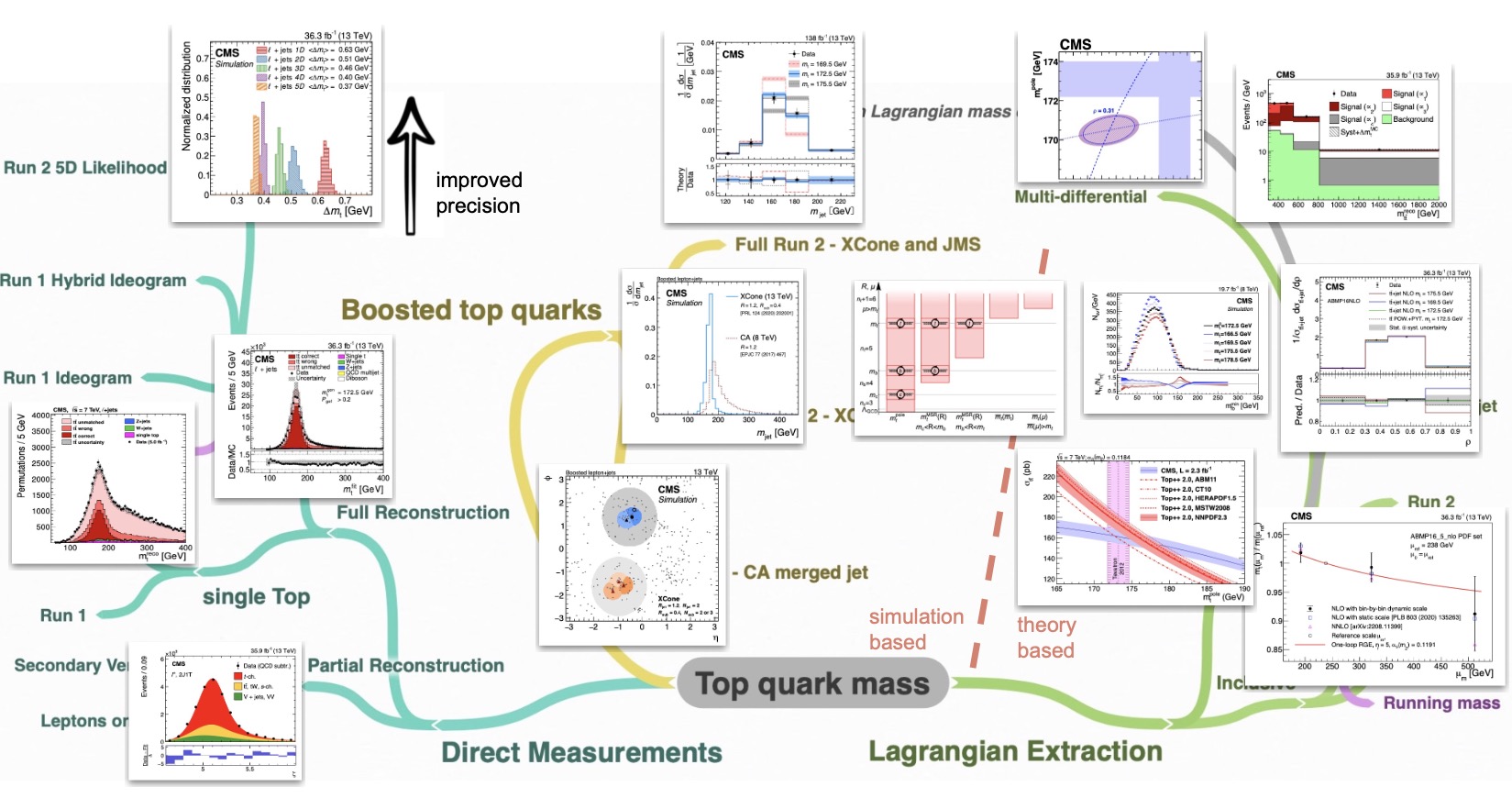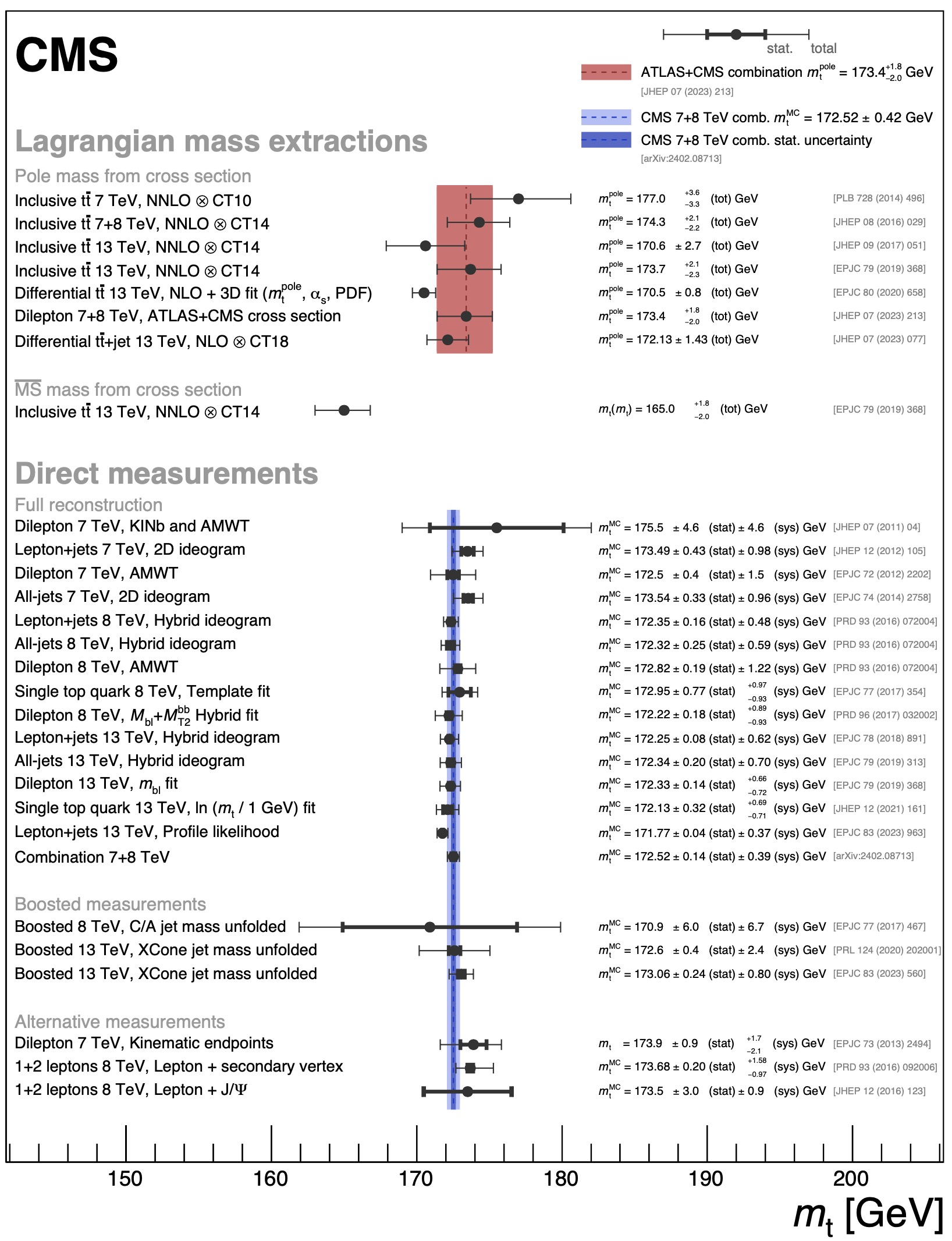
When it comes to top quark mass measurements, the CMS collaboration has the largest and most complete collection of publication-quality results, covering a wide range of methods and approaches. In a recent review paper, an overview is given of all top quark mass measurements published by CMS so far. In the quest to pin down the exact mass of this enigmatic particle, different methods were developed and perfected over the last decade.
The top quark takes the heavyweight crown, with the highest mass of all known elementary particles. The mass of this particle is so large that the Large Hadron Collider at CERN is the only particle accelerator in operation that is powerful enough to produce top quarks in large numbers. In part due to its large mass, the top quark can significantly affect many other interactions and processes. To understand the effects that the top quark has in the Standard Model of particle physics (SM), it is crucial to measure the top quark mass, mt, with the best possible precision. Its lifetime is so short (5 x 10-25 s) that perturbations caused by the strong nuclear force are relatively small, and the top quark can almost be considered as a free particle (or a “bare quark”) in the scope of the CMS measurements. However, there are limitations to this picture, which are also discussed in the review paper and affect the interpretation of the most precise top mass measurements.

Figure 1: Different methods explored by CMS to measure the top quark mass.
In this review, the major strategies to determine mt are grouped into three categories, illustrated in Fig. 1. The first category contains the “direct measurements” of the mass of the top quark decay products. Such measurements are very powerful: the most precise single-experiment measurement to date falls into this category. However, the potential to reach ultimate precision in direct mt measurements is limited by the current description of the top quark as a free particle in the Monte Carlo simulations used in experimental analyses. The difficulties in converting the measured mt values in the theory parameter relevant in the SM are addressed by the second category of investigations. There, the measured rates of top quark pair production, alone or associated with additional jets, are compared to the theoretical predictions for different mt values, to evaluate the value that provides the best data-theory agreement.
Finally, a special, third category of mt measurements focuses on top quarks that are produced with a lot of extra energy. These “Lorentz boosted” top quarks have a velocity of at least 90% of the speed of light, and their decay products are caught in a single “jet”, clustered in a small area of the detector. This allows the decay products of each individual top quark to be associated with their mother particle more clearly, leading to a powerful complementary experimental approach. It also offers beneficial theoretical properties. Given the higher energy required to produce this class of top quarks, the rates are relatively low. With increasing energy and integrated luminosity, the three CMS results obtained using boosted top quarks have improved the measurement precision by almost a factor 10 (as seen in Fig. 2), and the prospects for further improvements are especially promising in this case, with the large data samples expected in the future runs of the High-Luminosity LHC.

Figure 2: Spectacular improvement in the precision of boosted top quark mass measurements in three consecutive CMS publications, thanks to additional data and improved methods.
In Fig. 3, a selection of results is mapped onto the roadmap that was previously introduced. In each of the three main analysis categories: direct, boosted, and Lagrangian extraction, the measurements have evolved towards increasing precision, reaching relative precisions well below 1 per mille on the value of mt.

Figure 3: Evolution of a variety of analysis methods, following different roads towards complementary and ever more precise determinations of the top quark mass.
Figure 4 shows an overview of all resulting mt values. All measurements give a consistent picture. The direct and boosted top measurement results are compared to a recent combination of the direct measurements performed at 7 and 8 TeV, taking into account all statistical correlations between the measurements, represented by the blue band. The determinations of mt using the Lagrangian extraction method are compared to the red band that is derived from the ATLAS+CMS combination of the top pair production cross sections at 7 and 8 TeV. To properly compare all results in a unified manner and reach an even higher precision, further developments are needed, not only regarding the experimental measurements but also in terms of the Monte Carlo simulations and theoretical interpretation.

Figure 4: Overview of 29 top mass CMS measurements. The markers display the measured value while the statistical and total uncertainties are shown as horizontal error bars.
Given the complexity of the processes involved, the manifold analysis methods employed and the consistency of the results give confidence in the reliability of the SM. The precise determination of mt is an ongoing endeavour that fosters a close collaboration of the experimental and theoretical communities, with bright prospects in the years to come.
Read more about these results:
-
CMS Paper (TOP-23-003): "Review of top quark mass measurements in CMS "
-
@CMSExperiment on social media: LinkedIn - facebook - twitter - instagram
- Do you like these briefings and want to get an email notification when there is a new one? Subscribe here

